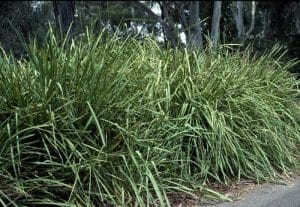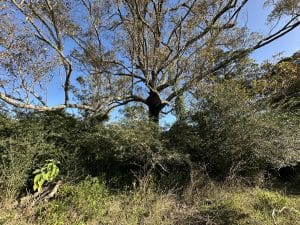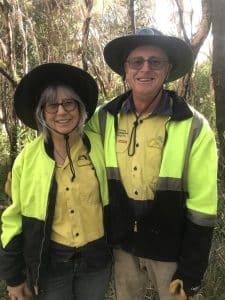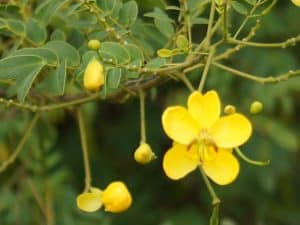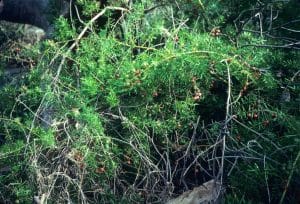 Fruiting now is the dreaded Ground Asparagus – a classic garden escapee formerly cultivated for its great hardiness (always a bad sign in an exotic plant!) and its pretty display of red berries (also a very bad sign – hello birdies!).
Fruiting now is the dreaded Ground Asparagus – a classic garden escapee formerly cultivated for its great hardiness (always a bad sign in an exotic plant!) and its pretty display of red berries (also a very bad sign – hello birdies!).
This vigorous, spiky, ridiculously tough plant is a Weed of National Significance due to its ability to form dense monocultures that can have devastating effects on biodiversity. It is capable of suppressing all other groundcovers, even smothering shrubs, and hindering the movement of native animals.
It is spread by birds, rats and even foxes, which are attracted to the vivid red berries. Each plant produces hundreds of seeds yearly – they are highly viable and can last for years. It can also be spread by plant parts – for example, dumping of the resilient “crowns” in bushland, or indeed in green waste, where they are capable of surviving.
This plant is a particularly nasty problem in coastal environments including dune ecosystems and littoral rainforests, but can also be a major pest of woodlands, riparian zones and wetland edges.
Its toughness makes it difficult to treat, but there are three methods that are effective in controlling it.
Its secret weapon in surviving adverse conditions is its tough, tuberous “crown” which gives off the spiky fronds above ground and a multitude of water-storing tubers below ground.
Instructions
Digging out and removing this crown is effective – this is achieved with a sharp tool like a Hori Hori knife or a serrated plasterboard knife (much cheaper!) – locate the crown and cut all around it, severing connections to the water-storing tubers, which can safely be left in the ground to rot. Crowns really need to be removed from bushland. If the tubers are removed and the fronds left attached, it will eventually dry out and die if left high and dry in vegetation, but if it can literally live for years, and if it finds the ground, it will re-grow! Any small segment of crown can regrow. A handy way to remove them (and other vegetative material you really need off the site) is to make a couple of belt-holes in a tough chaff bag and stow a bag on your hip to fill as you work – only take the crowns! Crowns should be sent to landfill for deep burial. Don’t put in the “green waste” collection – they are prone to surviving to contaminate any compost or mulch the green waste is processed into.
If it is difficult soil to dig in, the asparagus is too entwined with other plants you want to preserve, or you just don’t want to worry about carrying out the crowns, you can apply a stem-scrape technique – scrape every frond near the base to expose the cambium layer, and ideally also scrape or stab the crown, and apply neat or nearly-neat glyphosate with a dripper applicator.
If you have an overwhelming infestation, these hand techniques can become too time-consuming to be practical, and spot spraying becomes the treatment of choice. Spraying is most effective at flowering time. Use a 5L handheld unit or a backpack spray (don’t fill more than 10L, your back will thank you!). Asparagus has shiny “leaves” (callodes) with a waxy coating and does not uptake spray well. It’s essential to use a penetrant – “Pulse” and equivalent organo-silicone penetrants are recommended. To make up an Asparagus “hot mix”, start with 0.1g/L metsulfuron methyl 600 granules (eg “Brushoff”) (this equates to just covering the inside surface of the cap with granules for each 5L of mix) then add your water, then 1.5%-2% glyphosate, 2ml/L “Pulse” and a good splash (say 4ml/L) of Herbidye or equivalent. Dye is important – this mix will destroy most plants and you need to be very careful to avoid off-target damage. In a bad asparagus patch some degree of off-target damage to groundcover is inevitable and ground will be bared, so spray it out in stages rather than try to do it all at once. It is a good idea to prepare the area by moving asparagus fronds off native plants, and even under-pruning shrubs and small trees to reduce risk of leaf contact by the spray. This mix is also useful for other difficult weeds, for example, mother of millions. It should not be used near waterways.
As with any tricky weed management situation, don’t forget the three golden rules – follow-up, follow-up and follow-up.


